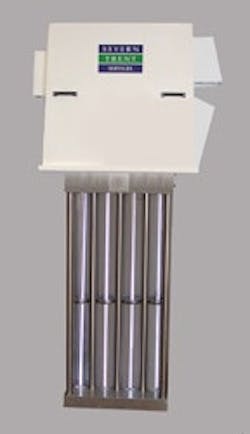| Related Searches from WaterInfoLink.com Microwave UV System | European Community (EC) Shellfish Waters Directive | Scottish Water | Severn Trent Services |
Situated 135 miles north of Glasgow, Scotland, is Tain, a small community of approximately 4,000 people. The country’s oldest Royal Burgh, Tain is in the Dornoch Firth, an arm of the North Sea, and is home to a diverse marine population. When it was designated a sensitive area under European environmental legislation, Scottish Water, the state-owned water and wastewater utility, was required to upgrade the existing Wastewater Treatment Works (WWTW) to comply with the European Community (EC) Shellfish Waters Directive.
The aim of the EC Directive is to protect or improve shellfish waters to support shellfish life, including oysters, mussels, cockles, scallops and clams. It sets physical, chemical and microbiological water quality requirements designating that shellfish waters must either comply with "mandatory" standards or endeavor to meet "guideline" standards.
In 2007, Scottish Water decided to upgrade the Tain WWTW with ultraviolet (UV) disinfection technology, which has proven to be particularly effective at reducing the amount of bacteria entering shellfish beds and bathing waters. Consequently, water companies often employ the technology along with filtration technologies to meet shellfish and bathing water directive consents.
The Tain WWTW is situated on the coast, and treated effluent is discharged directly into the Dornoch Firth. The dry weather flow (DWF) at Tain is 13.3 liters per second (l/s), the flow to full treatment (FFT) is 80 l/s (hydraulic limit) and the minimum UV transmissivity (UVT) is 45%. The WWTW site manager was responsible for the operation of several treatment works, so the Tain facility was often unmanned. As a result, key requirements for the UV system included simplicity of operation and maintenance, in addition to long-term reliability to cope with the UVT of 45%.
Scottish Water had previously installed MicroDynamics UV equipment at a number of its sites, including a wastewater system at Rockcliffe WWTW in 2003 and a closed vessel drinking water vessel at Larchfield in 2007. These units performed well with minimal supervision and maintenance required. Based on this experience, Scottish Water awarded Severn Trent Services and Ashbrook Simon-Hartley a contract to supply three MicroDynamics OCS 660 microwave UV generation units to Tain WWTW.
Microwave UV technology
Traditional UV disinfection technologies use mercury UV lamps containing electrodes to generate UV radiation. These electrodes are delicately constructed, and their deterioration is the primary source of disinfection system failures. In microwave-powered, electrodeless UV lamps, microwave energy is generated by a magnetron and directed through a waveguide into quartz lamps. These lamps produce predominantly monochromatic UV light, with the majority of the UV output at 254 nm disinfection wavelength.
Four electrodeless lamps are placed together inside a mesh waveguide, which directs the microwave energy into the lamps and allows the UV light to escape. This assembly is placed within a quartz sleeve. A cooling fan removes any buildup of heat within the sleeve, so the lamps maintain a constant output that is not affected by water temperature.
Since the electrodeless lamp has very low residual radiation of energy, the microwave UV system can be shut off virtually instantaneously. This feature prevents overheating of heat-sensitive materials near the lamps. Since the system employs electrodeless lamps, there are no electrical connections in the water.
There are two types of commercially available microwave UV disinfection systems: closed vessels for drinking water and small flows of wastewater and a modular, vertical open-channel system for large flows of wastewater.
The Tain WWTW UV system
The modular MicroDynamics units were installed in October 2007. The unique design of the electrodeless lamps, which have no electrical connections to fail, corrode or leak, ensures simplified and safer maintenance than traditional UV systems. The recommended regular maintenance for the Tain system was a three-year service interval and the annual replacement of the magnetron.
In addition, Severn Trent Services recommends the monthly inspection of the channel downstream of the modules to ensure the plant receives the wastewater quality that it was designed for.
More than one year after its installation at the Tain WWTW, no significant maintenance has been required other than the relatively minor replacement of one fan. The equipment is still performing well and meeting the stringent requirements for the EC Shellfish Directive, while continuing to use the original lamps and components.
“The performance of the MicroDynamics equipment at Tain has been excellent. A key factor for us in selecting the equipment was its reliability and ease of maintenance,” said Kevin McCreath, asset planning manager for the Ness Region.
